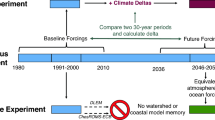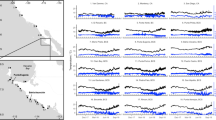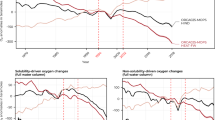Abstract
Millions of dollars are spent annually to reduce nutrient loading to Chesapeake Bay, with a fundamental goal of reducing the extent and severity of low dissolved oxygen (hypoxia) during the summertime months^1^. Yet despite recent reductions in nutrient loading, large volumes of the Bay continue to be impacted by hypoxia and anoxia during the summer months^2-3^. One obstacle to assessing efforts to improve water quality in the Bay and other estuarine systems is a complete understanding of the physical processes that modulate dissolved oxygen and the long-term variability of these processes. Here I analyze a 58-year data set of estimated hypoxic volume in the Bay^2^ and demonstrate the importance that wind direction plays in controlling the extent and severity of summertime hypoxia. This analysis indicates that wind direction explains a greater percentage of the observed inter-annual variation in hypoxic volume than estimates of nutrient loading. The implication is that physical processes play a dominant role in modulating hypoxia and that much of the increased hypoxia observed since the early 1980s can be attributed to changes in wind forcing that are the result of decadal-scale climate variability. These findings emphasize the importance of understanding the physical processes that modulate dissolved oxygen in coastal and estuarine systems and highlight the potential impact that climate change may have on water quality in Chesapeake Bay and other estuarine systems.
Similar content being viewed by others
Article PDF
Author information
Authors and Affiliations
Corresponding author
Rights and permissions
About this article
Cite this article
Scully, M. The importance of decadal-scale climate variability to wind-driven modulation of hypoxia in Chesapeake Bay. Nat Prec (2009). https://doi.org/10.1038/npre.2009.3308.1
Received:
Accepted:
Published:
DOI: https://doi.org/10.1038/npre.2009.3308.1



